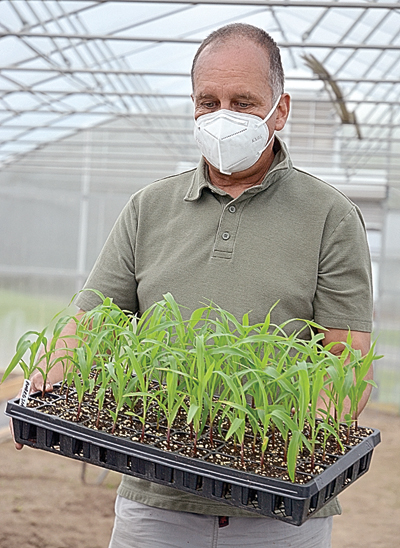

Laura Dean Bennett
Staff Writer
A high tunnel workshop was recently held in the high tunnel at Marlinton Middle School.
Pocahontas County Extension Agent Luci Mosesso; Casey Withers, of Ruby Grow, the High Rock’s agricultural venture; Catholic pastor and well-known local gardener Father Arthur Bufogle; and Steve White from Grow Appalachia Linwood spoke to local residents about high tunnel gardening.
Mosesso gave an overview of the process, from planting seeds to harvesting.
Withers talked about tools for high tunnel gardening and demonstrated a wheeled seed planter.
Bufogle shared his high tunnel experience and showed how to create perfectly spaced soil cells for starting seeds.
White discussed lessons learned about growing vegetables in a high tunnel.
The middle school high tunnel is situated on Rt. 219 in front of the school and beside the state police headquarters.
It was donated to the county by the West Virginia Department of Agriculture and was erected by volunteers during the 2014-2015 school year.
Marlinton Middle School students have been enjoying using it as an outdoor classroom and teachers report that it’s been an appropriate setting for teaching many subjects.
Humans have long known about the benefits of indoor agriculture. After all, the ancient Romans were using an early form of the greenhouse thousands of years ago.
The first greenhouse to appear in America was built in 1737 for Boston merchant Andrew Faneuil, and many of our founding fathers, including George Washington and Thomas Jefferson, had greenhouses, too.
But, in the last several years, a new form of semi-indoor agriculture, the high tunnel, has captured the interest of farmers.
High tunnels – some people call them hoop houses – differ from traditional greenhouses in that they are not permanent structures as most greenhouses are, and crops are grown in the ground in a high tunnel rather than above ground level as they usually are in greenhouses.
Also, high tunnels are not enclosed with glass, but with layers of heavy polyethylene sheeting.
The tunnels are usually about 14-by-30 feet wide by 30-by-96 feet long.
They are tall enough to comfortably walk in and to grow trellised crops.
Greenhouses use electricity and are typically heated, while high tunnels use the sun’s warmth for heat and wind for ventilation.
By opening the doors on either end and lifting the material on the sides, fresh air can be allowed into the tunnel to ventilate the structure and lower the inside temperature on hot summer days.
A high tunnel allows farmers to plant early and harvest later, dramatically extending their growing season.
And, if the high tunnel is heated, crops can be grown year around.
Winter growers should also consider installing small portable heaters for exceptionally cold days.
The additional expenses associated with high tunnel agriculture, especially during the initial set up, must be taken into account. But an extended season or year-round growing means marketing produce when demand is higher – increasing potential income per crop.
A high tunnel may also turn out higher-quality produce, as there is less chance of damage to crops by birds and deer.
Bugs and disease may also have a tougher time of damaging crops in a high tunnel, although there are some pests which thrive in the high tunnel environment.
For example, crops which suffer from mites, thrips, aphids and powdery mildew have to be closely monitored.
Row covers inside the high tunnel can reduce the need for pesticides and insect screens installed along the outside walls can deter intrusion by larger insects and small, four-legged plant predators.
High tunnels do a good job of protecting against extreme weather like damaging wind, hail, hard rains, snow and drought, but the structures can also be at risk themselves from severe storms.
High tunnels provide shade – which protects sensitive crops from heat and sunburn but, even so, many farmers find that fans come in handy during very hot weather.
With all of these considerations in mind, many Pocahontas County farmers believe the investment of money, time and effort is worth it.
“There’s a lot to be learned about high tunnel agriculture, but many farmers are finding that it can work for them,” Mosesso, said.
Steve White, director of Grow Appalachia Linwood, enjoys answering questions and working with local gardeners as well as large farming operations interested in high tunnel gardening.
“Our program helps to fund gardeners from Durbin and Slaty Fork to Green Bank and Marlinton, and they report the quantity of produce grown in exchange for the help,” White said.
“We’re finding that high tunnels can be a lucrative investment for many farmers,” he said.
“Lots of farmers are interested in high tunnel gardening, but are intimidated by the initial cost,” Mosesso said.
But there’s help available to Pocahontas County farmers to mitigate the cost of building a high tunnel.
“There’s a high tunnel cost share program available through the U.S. Department of Agriculture,” she explained.
“Anyone interested in the details of that program or anyone who has questions about gardening in high tunnels, please call us at the Pocahontas County Extension office.”
That number is 304-799-4852.
The Pocahontas County Extension Service will offer more educational sessions in the near future.
Look for sessions at the Marlinton Community Garden on such topics as trellising, pest control, weed control and canning and preserving foods.


